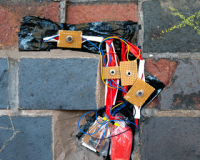Posted on Thu 26 May 2016
Geiger-Müller Sound System – A report
About us and our previous work

Posted by
Project

Studio Residencies 2012: Geiger-Muller Sound System
Supported by a Studio Residency writer, performer and composer Timothy X Atack and musician, sound artist and instrument designer MrUnderwood developed a finite kinetic choir.About us and our previous work
We’re Geiger-Müller Sound System. That’s the name we gave ourselves when we began working together at Watershed. Our individual component parts consist of 1. MrUnderwood [Sam], a sound artist and instrument maker, and 2. Timothy X Atack, a writer and composer (and author of this report.)
We’re both generalists – interested in many working practices, in adopting whatever method or approach seems right for any given project, and finding the right people to collaborate with each time. Working in a community of specialists and like minds at Pervasive Media Studio was immensely exciting to both of us. Before the artist residency we’d never met. But after we’d made separate applications the studio producers suggested we work together, having spotted a potentially interesting overlap in our proposed projects. They were right.

image: a Sonic Graffiti module by Mr Underwood, in the wild.
Both our applications were to explore how people interact with ambient and sometimes completely unpredictable sound installations. Sam wanted to develop a project called Sonic Graffiti which saw him leaving various noise-making / recording / playable electronic devices, unannounced, often unexplained, in built environments for people to stumble upon and use. Meanwhile I was keen to hone my writing practice for pervasive media after working on several complicated experiments in writing for interactive platforms, and especially eager to investigate notions of ‘invitation’; of designing the simplest and most elegant means of introducing a concept to participants, beyond which they’d be left to explore with as much freedom as possible.
On this basis I found Sonic Graffiti beguiling because of its cheekiness and lack of artistic self-regard, because of the clarity and confidence of its invitation – but also because, in a good and honest way, the artwork ‘promised’ very little, throwing its potential open to the participant. I’ve come to believe that as far as interaction is concerned, a good invitation is worth a thousand promises. Meanwhile, Sam was intrigued about how story might augment and expand the ambitions of the Sonic Graffiti modules, and particularly keen to give the project a kick up the arse in terms of sheer scale. A narrative hook of some kind seemed like one good way of doing this.
 image: a collection of dreams on VHS from a film by Timothy X Atack
image: a collection of dreams on VHS from a film by Timothy X Atack
It’s worth saying right now that the results of this residency very definitely met our expectations, and in some cases completely exceeded them. We’re both extremely happy with the outcomes (monstrous and unwieldy though they are.) We’ve received an intensive burst of support – both technical and conceptual – from the studio community, and from the public through the studio’s open-to-all events. A long-term collaboration with at least one core project at its heart has been sparked. I’ll start by describing that project, and then explaining how we got there…
The project
GMSS001 is a country-wide sound installation. It consists of the individual reed notes taken from a dying church harmonium (rotting, woodworm-infested, unsalvageable, but much loved) each one installed in a completely separate instrument of its own: a portable, handmade wooden box with hand-operated bellows. These one-note instruments will be scattered to the winds – we’ll leave them in flea markets, thrift stores, car boot sales, all over the UK. On the side of each box an inscription is carved, including our name for these instruments: a unique, carefully researched word, not yet found anywhere online (and hence not printed here.) Should anyone google the name, they’ll find other people who own these mysterious boxes. Maybe, one day, the instrument owners – or their children, or grandchildren – will get together and play chords from this long-dead harmonium. But there’s one final surprise in these boxes: should you play the single note for a few minutes, you’ll notice that another, stranger sound is emitted by the instrument. It changes over time, and a diagram carved into one panel of the unit seems to describe, obliquely, how you might expect this noise to develop; at first it’s chordal, then disintegrating and distorted, then finally sweet and heavenly. You might work out that it’s a hidden electronic component to the unit. But to hear the whole thing, you have to play the instrument for an hour – because should you stop, the sound completely resets, and you’ll have to start again.
 image: the prototype
image: the prototype
So in summary: WTF? Well, our thinking is that GMSS001 is:
- designed to last for as long as possible, to behave unpredictably, to have a life completely of its own.
- about decay, entropy, dispersal, and – maybe, one day – reconstitution.
- to outlive the people who created it in no uncertain terms, and in fact gives those original artists extremely limited say in what ultimately happens.
- aimed at long-term thinking, rewarding patience – both on an individual level (through the electronic component) and in terms of group effort (by being part of a possible chord.) It’s not about immediate return, fast profit, meaningless growth.
- Most likely, very expensive to make. But as regards that? See the last point above.
The process
We met up regularly in the studio on a part-time basis (2 – 3 days a week.) Our schedules meant that when Sam and I weren’t able to work together we’d often perform a sort of relay race, agreeing on research or content creation in advance and then taking stock once we were both ‘back in the room’. The idea was hit upon that we could use our online project diary to keep track of this discussion, having some of our conversation in public. This seemed to work well; it kept anyone interested in the loop, and often acted as a shortcut to more involved conversations with our producers and other studio residents – they’d seen our many vacillations and question marks along the way.

The first month of our residency was almost entirely taken up with throwing ideas at each other, walking around Bristol, scoping out locations, and – most importantly – re-iterating our individual aims and interests, constantly, making sure that our collaboration was on sure footing. Both of us had already built R&D into the heart of our creative practices: Sam is very clear on the ever-morphing nature of instrument design, and has a belief that even the ‘finished’ article should still be considered a prototype in many instances; and in my case, projects with my company Sleepdogs and band angel tech are always undertaken on the understanding that it might be a good few years until they’re fully realised (Sleepdogs have been making one particular short film since 2001.)
So we were both comfortable with the sometimes multi-faceted and sprawling nature of development. In fact we took it to extremes, and our first ideas centred around deliberately obtuse, unhealthy or even potentially life-threatening projects. Our name was derived from an early discussion that involved modifying a Geiger counter in order to produce more and more beautiful music the closer the user got to genuinely dangerous radioactive materials. Without batting an eyelid we dreamt up installations where everything appeared to be malfunctioning and hazardous, up to and including the all-pervading smell of gas being released into the room.
I’m sure our surroundings prompted these big ideas – there are people at Watershed literally trying to put stuff on the moon, it inspires a certain kind of thinking. We kept returning to ‘sounds of warning’, a joint love of alarms, beeping alerts, klaxons, pedestrian crossings. And this led – whilst Sam was on tour and gallivanting around Sweden - to me designing a collection of unlikely and dangerous instruments…


Upon Sam’s return we used the jumble of lists and concepts we’d generated to make a shortlist of 3 possible projects for further investigation (you can find a breakdown on our project blog.) Each was based on technical prompts from Sam’s Sonic Grafitti modules, combined with more oblique inspiration from my unlikely instrument designs.
Pretty quickly, we discounted the Harp For The End Of The World or ‘Tower of Guitar’… thanks to its structural, um, challenges. We’d resolved that a joint aim of the residency was to at leastmake something… and a set of bass guitar strings the size of suspension bridge cables, rigged to the Cabot Tower in Bristol, sounded like it might be a step too far. Then the changeable British weather nobbled what we thought was the front-runner, our Unit Of Resistance concept (a public sound installation that would become louder the more people joined hands around it) which was a shame as we had a nagging desire to make a political statement through the work, and this seemed the most obvious conduit. Unfortunately the sums got too complex and unwieldy when we began to factor damp palms and winter rain into our giant electrical circuit. But eventually we refined the third idea into something that felt navigable, and resolved to work on this throughout the remainder of the residency: we’d make some portable concrete boxes that would produce sound for 100 years, and would form a ‘choir’ when assembled.
We then shared an immediate, and sizeable, blip of doubt. I was experimenting with some odd post-apocalyptic texts for our concrete choir (you can read one of them here) and Sam was looking into how we might manufacture the boxes, but it wasn’t convincing somehow – and then, in a ‘what if?’ moment, inspired by a Zimoun artwork Sam had sent me links to right at the start of the residency, we talked about the harmonium that was decomposing in my back yard.

For years this had been my primary instrument. I learned to play music the way I do – often meditatively, huge spaces between notes – thanks to its particular qualities. But an incurable infestation of woodworm had banished it from my home, and it had been nagging at me for ages… so I suggested a way of modifying our choir project to deal with the harmonium’s imminent death, “making a ghost of it.” It gave me an emotional and narrative hook. And it gave Sam the opportunity to work with acoustic technologies that he’d always wanted to explore.
One particularly rewarding aspect of this residency has been the requirement that we give progress reports to our peers. These events come into their own if you’ve suddenly happened upon a really inspiring concept, but haven’t grasped the measure of it yet. The response to our harmonium idea was immediate and tangible. As we refined the details of the instrument(s) we were prototyping, some of the most important feedback came from public sessions where we speculated on taking either this route, or that route: the audience at the studio visibly warmed to some aspects, stared blankly at others.
 images: goodbye, harmonium. In-focus pictures by Sam. All other pictures by Tim.
images: goodbye, harmonium. In-focus pictures by Sam. All other pictures by Tim.
Construction of a gaffer-tape-and-mdf version of the instrument began straight away, and deconstruction of the old harmonium followed whilst we threw ideas around for how our boxes would be deployed. For a while we attempted to make the prototype completely weather-proof (which led to some interesting visits to trade stores like ‘Bus Parts’) until a work-in-progress audience led us, instead, towards the idea of leaving the boxes in shops, stores, markets and car boot sales.
 image: the gaffer-tape-and-mdf test instrument, surrounded by harmonium reeds. (Sam: “Quality workmanship is smooth gaffer tape.”)
image: the gaffer-tape-and-mdf test instrument, surrounded by harmonium reeds. (Sam: “Quality workmanship is smooth gaffer tape.”)
 image: Tim’s early and somewhat shonky photoshop visualisation of the instrument
image: Tim’s early and somewhat shonky photoshop visualisation of the instrument
The electronic challenges were more troublesome, especially our attempts to power the instruments kinetically. Sam and I both came to insist on certain key behaviours for the units not being compromised: the double-bellows system, the triggering of the hidden recording, the exterior detail. But for all its frustrations the project was simple enough in its central invitation to keep us focussed on a single joint aim. There’s a particular point, I learned, at which specific technical problems stop being an annoyance and instead become exciting. It’s breaking this ‘pain barrier’ that tells you your idea is worth the effort.
 image: stop labels from the harmonium… …and the mystery diagram etched onto our prototype
image: stop labels from the harmonium… …and the mystery diagram etched onto our prototype
Given that much of what we were doing involved smashing up dynamo-powered radios and playing harmonium drones that lasted for 45 minutes, our studio producers very kindly found us an impromptu studio space in an empty restaurant beneath the Watershed for the remaining fortnight of R&D. This was invaluable – keeping us close to PM studio activity but allowing us to make the loudest sounds possible in a big reverberant space. Most of our musical content was tested at this point; the slowly degrading tones we wanted to emanate from our electronic components, based on a final valedictory recording we’d made of the old harmonium.
 image: the Geiger-Müller Sound System pop-up studio
image: the Geiger-Müller Sound System pop-up studio
A characteristic of our collaboration began to emerge, which broadly speaking saw Sam asking “What does it do, and how?” and me addressing “What is it for, and why?” This isn’t to say that we didn’t each stray into each other’s territory (I found myself trawling the web for chattering switch components late one night, much to my surprise) but it made for a very satisfying balance. One of us always had a care for the technology, the other for the content.
Finally, we began talking to other collaborators. We overheard a conversation in the studio (literally) that introduced us to Laurens Nockels at model-makers Amalgam: they produced the laser-etched lettering on our prototype. Sam’s research took him to Birmingham Accordion Centre, and our bellows were constructed there by Mr Rob Beecroft. We left the final box only partially assembled to allow for future experiments, but the woodwork alone, by Alan Eldridge at Shaker of Malvern, was powerful enough to get us some very positive feedback at the final residency event in January 2013.
 image: prototype detail, including bellows (lower left) and reed / reed bed (lower right). Secondary bellows systems is just visible inside the box.
image: prototype detail, including bellows (lower left) and reed / reed bed (lower right). Secondary bellows systems is just visible inside the box.
What’s next
We still have a great many practical questions to answer about GMSS001, but the residency’s immediate legacy for us is a very clear trajectory over the coming months, and a building giddy excitement about what this project might become. We’re researching possible funding bodies and collaborators for the next stages, and through PM studio contacts we’ve already been asked to speak at an academic conference about our insane harmonium shenanigans – which is a new departure for both of us as artists.
A great deal of our process as described above has been about the simple discovery of common ground. But not being cramped or rushed, taking time and asking as many questions as necessary, with this degree of thoroughness, has only been made possible through Watershed’s support. It’s a fascinating model of work, and one I’d recommend for future residencies: find potential collaborators (preferably strangers) throw them together, and to all intents and purposes don’t tell them what to do.
I suppose, beyond our practices, there were other parallels to bear in mind that might have eased our working together. Before the residency Sam and I had both very recently quit our day jobs, we’re of comparable age and background, we both have silly beards, etc. But I think the most successful aspect of the collaboration was in a well-identified balance of skills and influences, and on our part a willingness to adapt them for the residency. I find it particularly fascinating that we ended up working on an ostensibly ‘low-tech’ concept in a high-tech environment, and no-one objected for a moment. It’s in these sorts of ways that I feel truly supported by the residency scheme, and I’m sure it’s why Sam and I are already talking about GMSS002 and beyond.
 image: a craftsman, at work.
image: a craftsman, at work.
